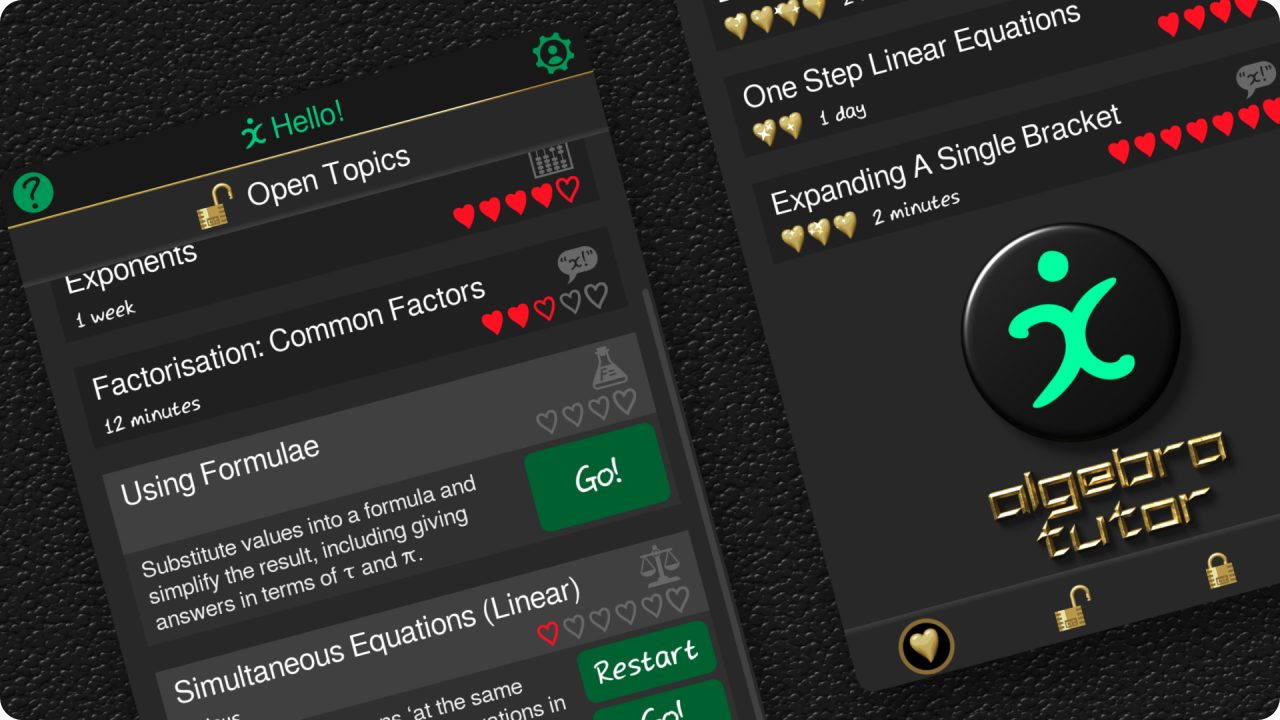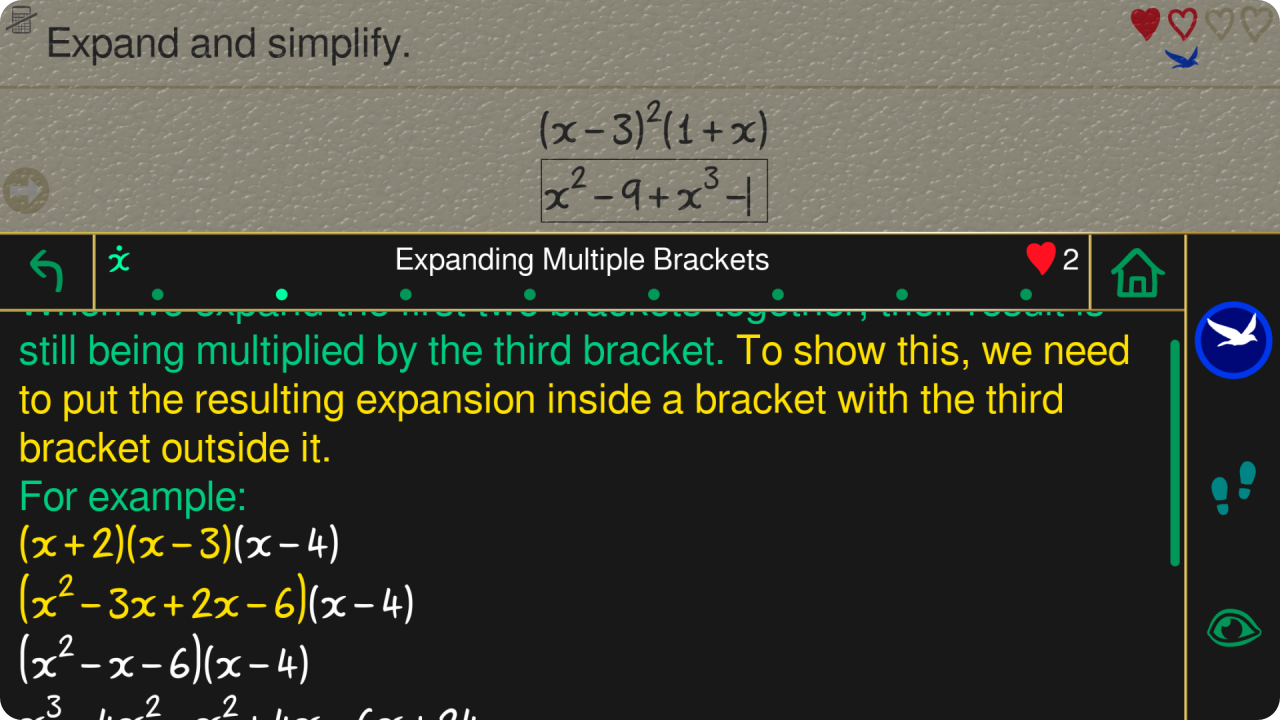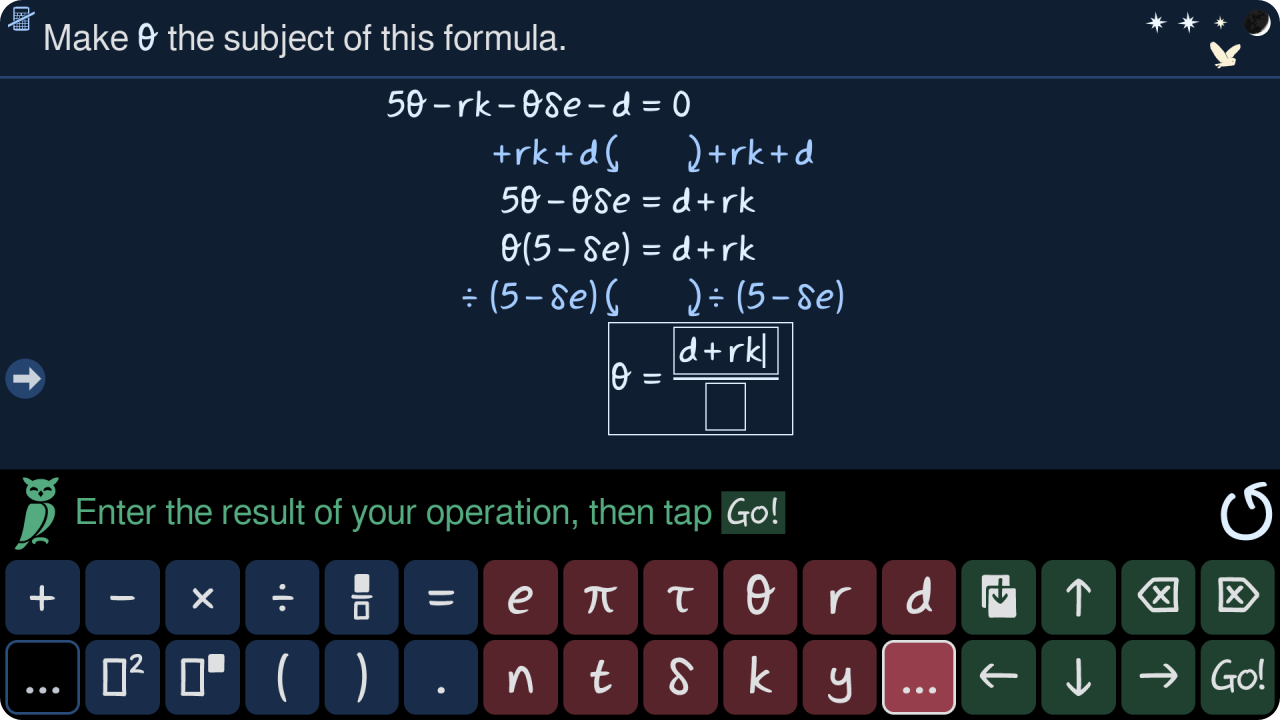
Begin your journey into the language of mathematics with Algebra Tutor - the fun, free algebra course that brings maths to life!





Download Algebra Tutor free:
Apple and the Apple Logo are trademarks of Apple Inc.
Google, Google Play, the Google Play logo, YouTube, and the YouTube logo are trademarks of Google LLC.
Mastery Learning
Rather than simply moving on when something isn’t correct, Algebra Tutor is designed to help you keep going until you successfully complete each task.
Mr Green is always on hand to offer hints, tips, and examples.
You’ll cycle through 3 important phases of learning as you meet each new skill...
Show Me Mode
Experiment as you learn how to complete tasks. You choose what steps to take, and algebra tutor will show you their effects with animations helping to build your understand of the ‘why’.
Step Check Mode
Work on your accuracy as you progress onto entering the results of your chosen steps. You’ll be prompted to correct any mistakes as they happen, while you consolidate your understanding of the methods.
Independent Mode
Time to go solo! Practise checking your working. You can go back to edit any line as needed.
Algebra Tutor determines from your responses when to move into a different mode, and you can choose to change mode on a particular task if desired.
Revision
Complete topics to access revision tasks and unlock other topics that build on those skills.
Revision badges can help you gradually increase the number of days between revision tasks, so as to get topics into your long-term memory.


Algebra Tutor Topics
Tap the category icons above to see details of the topics in Algebra Tutor.
The hearts indicate the number of sections in each topic.
 Expression Topics
Expression Topics
Terms
Meet some of the notation used in algebra, see what makes up an algebraic ‘term’, and begin simplifying terms.
Expressions
See how ‘sums’ are made up of ‘terms’, try simplifying expressions by ‘collecting like terms’, and meet some of the names given to particular types of terms and expressions.
Building Algebraic Expressions
Learn to recognise what each operation in an expression is acting on. See how the operations in an expression can be thought of as happening in a particular order, and, starting with x, apply a sequence of operations to build up a given algebraic expression.
Get Back To x
Operate on given expressions to ‘cancel’ things out until we ‘get back to x’ on its own. This topic deals only with expressions, but the skills developed here are important in solving equations.
Expanding A Single Bracket
See how to ‘expand’ a single bracket that is being multiplied by another factor, then practise number and simplification skills as we continue expanding brackets within expressions.
Factorisation: Common Factors
An introduction to factorisation. Learn how to ‘take out’ common factors from the terms in a sum to express that sum as a product of factors.
Expanding Multiple Brackets
See how to ‘expand’ brackets when there is more than one bracket factor being multiplied together, including terms with a squared bracket factor, and expressions with more than one term to expand.
 Equation Topics
Equation Topics
One Step Linear Equations
An introduction to solving equations. Meet the underlying concepts and practise number skills as we attempt linear equations that can be solved in a single step.
Multi-step Linear Equations
See how to solve linear equations by applying a sequence of operations to each side, and practise number skills as we continue solving.
Unknown On Both Sides
Learn how to solve equations in which the expressions on each side both have a term containing the unknown.
Unknown In A Denominator
Learn to solve equations that have the unknown in a denominator, including when the unknown is a factor of the denominator, and when the denominator is a sum.
Simultaneous Equations (Linear)
‘Simultaneous’ means ‘at the same time’. Learn to solve linear equations in more than one unknown, by using more than one equation simultaneously.
 Formula Topics
Formula Topics
Changing The Subject
Change the ‘subject’ of a formula by applying operations to it, so that it becomes equal to something else.
Using Formulae
Substitute values into a formula and simplify the result, including giving answers in terms of τ and π.
 Number Topics
Number Topics
Number Practice
Practise times tables, negatives, fractions, decimals, and powers.
Exponents
Deepen your understanding of exponents (also known as ‘powers’ or ‘indices’). Meet some ‘laws of exponents’ and see what zero and negative exponents mean. (We’ll deal mainly with integer exponents here.)
 Topics In Development
Topics In Development
Quadratics
The next set of topics we hope to release are about quadratic expressions and equations. We intend these to cover: factorisation of quadratic polynomials into double brackets (including the difference of two squares); completing the square; simplifying expressions that include quadratics within algebraic fractions; using these skills, as well as the quadratic formula, to solve quadratic equations; and the solving of simultaneous equations that include quadratics.
Trigonometry
We have done significant development on solving trigonometric equations and hope to create topics on this, as well as on the use of trigonometric formulae and identities.
Exponentials And Logarithms
One topic on exponents is already included in Algebra Tutor and we have at least one more planned, as well as topics introducing logarithms, their rules, and their use in simplifying and solving equations.
About Us
The Algebra Tutor app was created by former Secondary School Mathematics Teacher, Dave J Green, and Software Engineer, Jonathan Green. After more than three years of full-time development, we were pleased to release Version 1.0 in the summer of 2021.
Algebra Tutor is designed to help students develop more confidence with algebra, so that its use does not become a barrier to them as they explore the fascinating world of mathematics. The app aims to prevent misunderstandings of algebraic notation and facilitate mastery of common algebraic skills.
We hope to continue developing Algebra Tutor by adding many more topics and features in the future. For now, please download the app and try it out!
You can also checkout this interactive number grid based on Eratosthenes’ sieve, which is great for introducing children to the concept of prime numbers. Or, if you just want to play a game with a friend over the internet, try out the Algebra Tutor themed noughts and crosses here.




